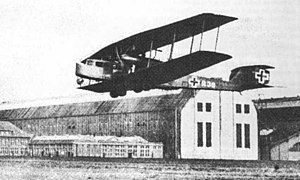Zeppelin-Staaken R.IV
| Zeppelin-Staaken Riesenflugzeuge | |
|---|---|
 |
|
| An R.VI taking off | |
| Role | Bomber |
| National origin | Germany |
| Manufacturer | Zeppelin Werke Staaken GmbH (Zeppelin-Staaken) |
| Designer | Ferdinand von Zeppelin & Robert Bosch GmbH |
| First flight | 11 April 1915 |
| Primary user | Luftstreitkräfte |
| Produced | 1915–1919 |
| Number built | 37 (all marks) |
| Variants | Zeppelin-Staaken R.V, Zeppelin-Staaken R.VI, Zeppelin-Staaken R.VII, Zeppelin-Staaken R.XIV, Zeppelin-Staaken R.XV, Zeppelin-Staaken R.XVI, Zeppelin Riesenflugzeuge |
The Zeppelin-Staaken Riesenflugzeuge (IPA: [ˈtsepːelin ˈʃtaːken ˌʀiːzenˌfluɡˈtsɔjɡe]) were a series of very large bomber aircraft - Riesenflugzeuge ("giant aircraft"), usually powered by four or more engines, designed and built in Germany from 1915 to 1919.
The first Zeppelin-Staaken R-planes were designed by Ferdinand von Zeppelin, aided by Robert Bosch GmbH (engineers), the V.G.O. I, (Versuchsbau Gotha-Ost), was built at Gothaer Waggonfabrik due to lack of facilities at the Zeppelin works, hence the V.G.O. Designator. This large aircraft set the seal on what was to come, with a 42.2 m (138 ft 5 in) wingspan it was very large by the standards of 1915, and its wing planform and general wing structural dimensions would be used, almost unchanged, for the entire series of Zeppelin-Staaken giant aircraft. Other design traits were: nacelle-mounted engines, with the strut-mounted nacelles suspended between the mainplanes on either side of the fuselage — these possessed accommodations for engineers and/or gunners; an engine installed in the nose; tricycle undercarriage with the aircraft able to stand nose down or tail down onto a tail-skid; a box like tail unit with biplane tailplanes and twin fins with rudders (some later variants also had a central fin).
The engine installations differed with each aircraft type but generally followed the layout of a single nose engine, usually driving a two-bladed propeller and with the interwing engine nacelles on either side suspended by struts between the mainplanes each housing two engines in tandem, geared to drive single pusher propellers.
Engine installation variations included;
Construction of the aircraft was almost entirely of wood or plywood with fabric covering, steel detail fittings and struts. The wings were three bay strutted and wire-braced assemblies supporting the engine nacelles, at around mid gap and the single axle main undercarriage units. Despite the wide variations between all the Staaken R-series variants in their engine configurations, the identical 42.2 meter wingspan figures for nearly all of them indicate that nearly identical wing layouts were likely shared by almost all the Zeppelin-Staaken R-series designs built. The square-section fuselage, with curved decking forward of the wings, supported the tail unit and nose twin wheel single axle nose undercarriage and housed the majority of the crew, defensive armanent positions, cockpit, cabin, and bomb load. The later versions, especially the "production" R.VI version, used pre-printed lozenge camouflage on their fabric covering in the attempt to "conceal" them on their nighttime operations over the U.K.
...
Wikipedia
